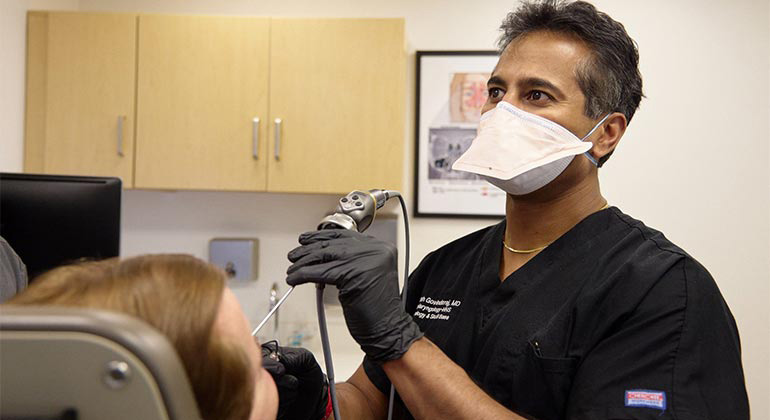Aspirin Exacerbated Respiratory Disease (AERD) Care at Mount Sinai

Mount Sinai’s Rhinology and Sinus Surgery team is making advances in the treatment of aspirin exacerbated respiratory disease (AERD), which is associated with congestion, infection, and sinus pain. Although there is no cure for AERD, new treatments offered at Mount Sinai are effective in minimizing symptoms and the risk of recurrence. As with any condition, early detection and treatment are best, but Mount Sinai physicians are able to achieve positive outcomes among patients regardless of severity or length of time before diagnosis. These innovative approaches to treatment continues to set standards for success among patients with AERD.
About Aspirin Exacerbated Respiratory Disease
Aspirin exacerbated respiratory disease is a chronic condition characterized by three factors: asthma, recurring nasal polyps, and issues related to taking aspirin and non-steroidal anti-inflammatory drugs (NSAIDs) such as ibuprofen and naproxen. Most people do not experience symptoms related to AERD until they are in their 30s or 40s and the nature of these symptoms means it is often difficult to diagnose.
Despite its name, AERD is not caused by taking aspirin or NSAIDs; however, these medicines can exacerbate AERD-related symptoms, such as congestion and asthma. In fact, there is no known cause of AERD and there are no indications that it is genetic, inherited, or an allergic response.
Estimates suggest that 7 percent of adults with mild asthma and 14 percent with severe asthma have AERD.
Symptoms and Diagnosis of AERD
Patients who have AERD typically present with asthma, nasal congestion, and nasal polyps that are non-responsive to treatment. Many patients also experience loss of smell and nasal infections, and they experience negative reactions in both the upper and lower respiratory system when taking aspirin or other NSAIDS. These reactions include congestion, sneezing, sinus pain, wheezing, and coughing. In some cases, patients may also experience a rash or reddening of the skin, abdominal pain and, less commonly, vomiting.
No official diagnostic test exists for AERD. Hence, the diagnosis is primarily determined upon three key factors:
• Asthma
• Nasal polyps
• Aspirin-related respiratory issues
Clinical tests can be helpful in confirming diagnosis. These include a blood test to detect elevated levels of eosinophils (white blood cells) or a urine test to measure any elevated levels of leukotriene (chemicals that can result in inflammation and swelling in the airways).
In cases where patients have no clear history of NSAID-related reaction, they will be asked to do an aspirin challenge for confirmation. This involves oral, or a combined oral/intranasal delivery of the medication in a medical setting guided by a physician.
Treatment for AERD at Mount Sinai
Although no cure exists for AERD, several treatment options can help patients manage symptoms. These include intranasal steroid sprays and steroid sinus rinses—which can ease symptoms such as congestion—and oral steroids, which can help treat nasal polyps. There are also non-steroid medications such as zileuton that can prevent the production of leukotrienes, and montelukast and zafirlukast, which help block their function. These treatments should be taken daily, often in combination, for optimal outcomes.
Often, rhinologists will recommend surgical removal of nasal polyps for AERD treatment; however, the likelihood that they will recur is strong. To lower that risk, patients may undergo subsequent aspirin desensitization. This approach involves gradually increased doses of aspirin administered by a physician in an outpatient setting over a two-day period. Once completed, patients will take daily doses of adult-strength aspirin, which may help reduce the need for oral steroids and prevent nasal polyps from recurring. Missing a day or two of aspirin may require repeating the desensitization procedure.
For patients with a high risk of medical and surgical failure, such as those patients with recurrent nasal polyps and/or with narrow frontal sinus drainage pathways, the Draf III procedure (also known as a Modified Lothrop Procedure) might be an option. This surgical procedure is designed to open and widen the frontal sinuses by removing obstructive cells and the uppermost area and floor of the nasal septum to create a common frontal sinus cavity. This facilitates medicated irrigation delivery, as we as allows removal of polyps in the office to avoid future surgeries under general anesthesia. Mount Sinai rhinologists are vastly experienced in this specialized procedure, which is performed through the nose using mini telescopes and intraoperative (image-guided) navigation.
Mount Sinai patients also have access to several biologics as part of their treatment regimen for AERD. These include mepolizumab, benralizumab, reslizumab, and dupilumab, which are effective in treating moderate-to-severe eosinophilic asthma, and omalizumab, mepolizumab, and dupilumab which are effective for cases involving chronic rhinosinusitis with nasal polyps.